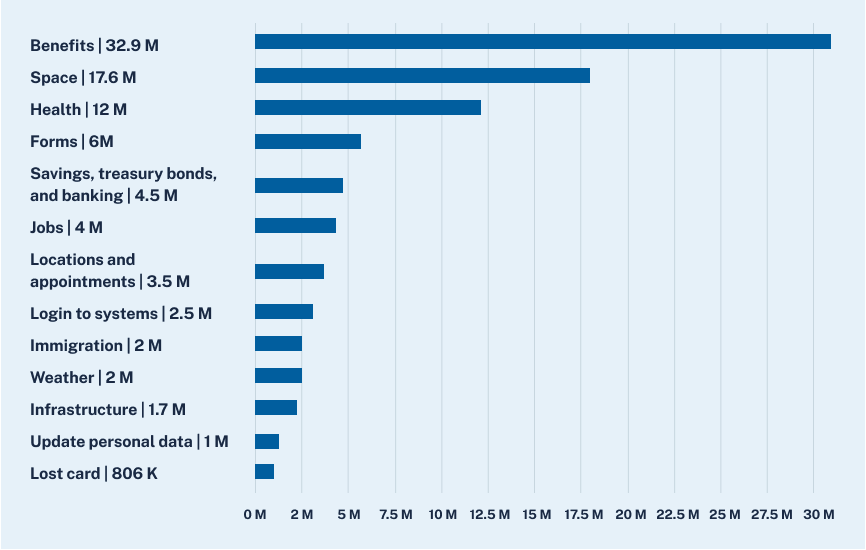Overview
For the past several years Search.gov has reported each year on the top public needs based on the search terms they used.
This special report will take a different approach. It still offers a high-level view of the public experience of seeking services and information from the government. But it also tells the story of change, and how these changes affect search and findability.
In many ways, digital communications mirrors “government of the people, by the people, and for the people.” Web teams across government work hard to deliver on agency missions and support the public, while following legal and policy requirements of law and policy.
Publishing a website requires many people, so Search.gov can contribute our search expertise if teams need it.
Many people don’t know that designing a website affects content findability, especially external services like commercial search engines.
Searching is a bridge between a person and what they seek, when they don’t know where to go, or what they need. If the search engine’s index is not updated promptly and constantly, the public will be blocked or confused as they try to find things on the new website.
Search.gov supports agency web teams throughout their redesign process to reduce that confusion. We’ve found the most common pitfalls are:
- Design: Page template structure
- Content strategy: URL redirect strategy (or lack thereof)
- Content migration and testing: Redundant placeholder text
- Rollout: Sitemap formatting and placement
When teams are deep in working out a redesign, they need an external review to lay the foundation for a smooth search transition.
2022 was a year of tremendous change for federal digital communications, as agencies work to meet the public’s needs, as well as new legal and policy requirements. Search.gov too has experienced great changes resulting from these laws and policies, and other enabling factors. This trend of change continues across government, and is gathering momentum.
In this special report, we discuss a website redesign’s nine phases and their impact on search. If your agency has the resources, you can conduct many of these phases at the same time.
If a small team tries to conduct multiple phases at the same time, this will likely extend the timeline. Also, you can conduct some of the phases in a different order from what we present here, and indeed the outcome of one phase may indicate revisions are needed in previously completed phases.
2022 top topics in search
While this year we focused on website modernization and its impact on search and findability, the public still has searched for services and information like any other year.
Here is a high level summary of the top interests across participating agencies during 2022.
- 291,392,854 queries
- ~2,200 gov websites
- 365 days of connecting people with what they need
- 13 top topics

Recent website migration context
Beginning in 2022, many more agencies have relaunched their websites, compared to previous years. Several factors combined to create the right conditions, including new laws and funding priorities.
The 21st Century Integrated Digital Experience Act (21st Century IDEA) lays out several requirements to improve the quality of government websites and other digital services. Specifically, agencies were told to modernize their websites, and report their progress to Congress and the public each year. (21st Century IDEA text, related Digital.gov resources)
In the four years since the law was passed, agencies have
- Made their plans,
- Acquired development support services, and
- Got through all the phases of redesign.
This report focuses on the phases of redesign.
The Executive Order on Transforming Federal Customer Experience and Service Delivery to Rebuild Trust in Government (CX EO) focuses on major life events where people need to interact with the government. It directs several agencies to improve the processes and systems people need to use during these moments, including websites and online tools for requesting and receiving help and services. (CX EO text, related Digital.gov resources)
Congress has also approved funding in recent years, which has driven digital services improvements. Examples of this funding include:
- The Technology Modernization Fund (TMF) was created to provide incremental funding for projects that show potential for significantly improving user experience or security.
- The Coronavirus Aid, Relief, and Economic Security (CARES) Act was passed to help the American public in a time of crisis. While the CARES Act did not target web improvements specifically, many of these improvements helped carry out the act’s purpose. These improvements include updating data collection, service delivery, and application systems.
- The American Rescue Plan (ARP), passed in 2021, supplemented appropriated budgets across government, to ensure services and programs were able to deliver on their missions to the public. This often took the form of improving the digital space.
Conclusion
Search.gov has the privilege of working with government agencies of many different sizes and missions. 2022 brought an unusually high number of website relaunches, and this trend continues. These relaunches have allowed us to work more closely with many teams, get to know them and better understand their goals, and align our roadmap and timeline more closely with theirs. We apply lessons learned from one agency’s redesign to the other agencies we work with, improving processes across our customer base.
Contributing our expertise during a website redesign allows the agency teams to focus on the website itself, making sure that it meets the needs of the public, as well as agency goals in serving the public. Almost all phases of a redesign have an impact on search experiences and SEO. We offer support to ensure the foundation for a good public search experience is secure for each website, especially:
- Technical SEO components are implemented correctly, including page templates,
- Content-based SEO components are in place
- The indexing process is managed smoothly
We look forward to many successful website redesigns in the future.
Acknowledgements
Our thanks to our partners who graciously shared their stories for this report.





